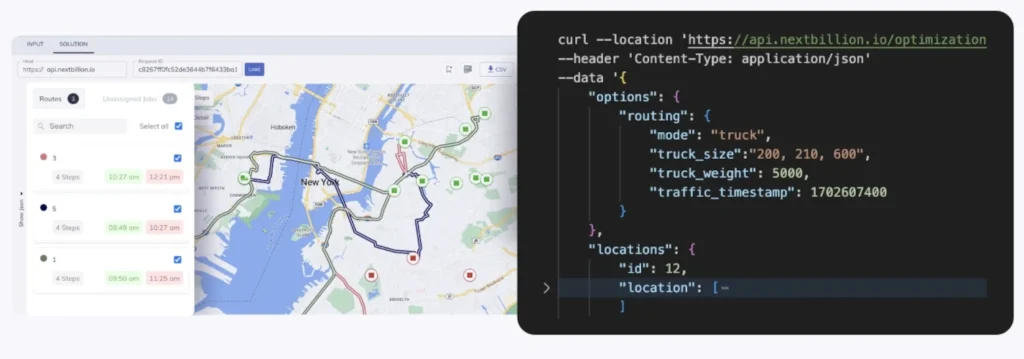
Table of Contents
While your doorstep delivery services are expanding to the farthest corners, an undesirable issue of failed delivery attempts is severely impacting the whole business model.
It is true that the end customers get irritated with such response messages by the delivery agents. But a prominent fact is that service providers like you also suffer the due loss in multiple aspects.
Read through the article below to find out what does delivery failed means concerning your customers and company. There are some amazing tips to tackle transportation issues, and how Nextbillion Route Optimization API can resolve failed delivery attempts.
We’ll discuss the most common reasons for unsuccessful delivery attempts. But let us begin with understanding delivery attempts.

Explain Delivery Attempts and When is it Considered Failed.
Courier companies assess their earliest date and time for delivering the docket, which depends on multiple factors like the end-customer’s location, dimensions of the package, etc. Integrating an appropriate On-demand delivery API with the database management tool conveniently automates the whole process.
Once the docket reaches the station point near the delivery address, on or before the due date, the company assigns field agents to deliver the box. It is the first delivery attempt by the carrier delivery person to the end customer.
Note: There can be various reasons when the shipment transition stays unsuccessful. Often the product does not reach the station point in due time or the customer is unavailable to receive the package. In such cases, the delivery attempt fails.
Let us explore some common causes of failed deliveries, and how it can be avoided.
What Causes a Failed Delivery Attempt
There can be various scenarios when the customer encounters a notification unveiling a failed delivery attempt and does not receive the product on time. A few are discussed below.
Package not ready:
It is embarrassing for a courier company if they cannot avail the package at a location on a committed date and time. This may be because the consignment was not picked up on time by the pickup team, or mismanagement at the docket centres due to lack of staff or bulk of orders in a short duration.
Note: Cloud ERP or CRM platforms are useful in managing staff and workload but it is advisable to comply with flu-fledged usage by integrating a route optimization API and minimise service lags.
Delays due to technical failures:
There are scenarios when pickup vehicles break down resulting in unsuccessful delivery attempts to the centers or to the customer. It is best to have a mechanism that immediately reports to the hub about the issue, and thus, dealt with suitably.
Delays due to natural conditions:
Not everything is under your control, especially the unfavorable weather conditions for traveling, which may lead to inefficient delivery results.
Large or weighted box:
It is essential to evaluate the size and weight of large boxes, which may affect the delivery time slots. You should utilize specialized tech solutions to allot vehicles and trained drivers for handling packages in such special categories.
Lack of Staff:
It was observed during pandemics that organizations in different sectors had to undergo a lack of staff situations. It may also happen during sale durations, festivals, or lay-offs when you need to effectively manage your staff and specially the drivers. Optimizing their routes with an automated system is an effective solution in this case.
Customer not available:
This is something which the delivery agents cannot do much about and lead to failed delivery attempts. Intimating to the customer through calls/ emails is a critical step before reaching the location.
Inaccurate address details:
Often customers make such silly mistakes by entering wrong address details, or in some cases when the address is noted down through tele-callers, they miss out on information. In such cases, the customers receive unsuccessful delivery attempt notifications.
Unexpected traffic conditions:
Unmanageable traffic is a major cause of late arrivals for any rider on the streets. There are few peak hours when the traffic gets stuck with minimal movements, and finally, the carriers have to return and re-schedule the failed deliveries. It is advisable to integrate a reliable Navigation API that fetches map and traffic data from trusted sources. The drivers get useful insights about the traffic and ETAs on their smartphones.
While successful courier delivery is your primary goal, it is evident to maintain a higher first-attempt delivery rate. Let’s find out more about this parameter.

Calculating First Attempt Delivery Rate
A courier company needs to ensure their orders are successfully delivered on the committed time. The delivery managers always keep a check on maintaining efficient deliveries, which is prominently known as first attempt delivery rate or FADR.
Note: The courier delivery service is approximately valued at $466.79 billion in 2024, and is expected to rise by $602.47 billion in 2033. Here the timely delivery of products is one of the major factors shouldering success to these companies.
It is evaluated by calculating the percentage ratio of first-attempt deliveries against total deliveries. So higher the percentage of FADR, the higher the efficiency.
FADR has high significance in customer satisfaction, staffing, upskilling sessions, and technology upgrades. Some organizations have rightly termed it as First Time Right or FTR. Consistently low FADR can have unsuitable impacts on your logistics business.
How Does Failed Delivery Attempts Affect Your Brand?
While your managers target 100% FADR, it isn’t always possible to get the process done on an ideal course. But every failed delivery leads to follow-up procedures that reduce work efficiency and negative feedback as well.
Note: You might have to spend more on reputation management and branding to deal with negative responses online.
Charges estimated on a package delivery are based on first attempt delivery considering the several logistics costs. But you have to bear the price of failed attempts in terms of fuel charges, storage maintenance, or safety & security of the package.
Multiple laborers get involved in loading, unloading, and reloading the consignments on the delivery trucks. This adversely reduces the space for other packages in the queue. An undeniable fact is that your courier company can also be legally penalized for underperformance if a client sues the case in court.
An increase in pending workload creates hastiness among the staff and work culture. Above all, your customers feel dejected if they don’t receive the services for which they paid or opted.
Therefore, it is critical to avoid failed delivery attempts, and here is what you must do to achieve it.
Effective Solutions to Avoid Failed Delivery Attempts
As an expert and experienced logistics firm, you must motivate the team members to maintain a disciplined workflow environment. It is necessary to ensure that each concerned department follows preset criteria for handling package delivery service procedures.
Note: Make sure the customers provide complete postal addresses with nearest landmarks, and phone numbers for instant communication.
If the management expects to prepone or postpone the deliveries, it is best to communicate with the customers before the agent arrives at the location.
Pre-informing the receivers about rescheduling the docket transition time reduces the chance of failed delivery attempts. The tele-supporters or drivers can re-confirm about their delivery or ask them to provide an alternate communication address, if possible.
Tracking the delivery package through an automated system generates a holistic approach to fulfilling successful delivery attempts. The technology solution devised by NextBillion provides real-time updates regarding package deliveries or delays due to specific reasons.
Read the article before considering a Route Optimization API
Your sales-support staff can follow up with the customer’s tracking ID. It assists the team in re-confirming product deliveries or any reasonable delays on the route, thereby communicating the updates to the customer.
Leveraging Technology for Efficient Delivery Management
Companies working in the logistics sector opt for a definite solution that can assist in efficiently planning the routes for the delivery agents. NextBillion Route Optimization API automates the process of strategizing the goods transportation channels. You achieve better performance in terms of fuel consumption, time windows, vehicle selection, or preventing failed delivery attempts.
The NextBillion Route Optimization API integrates with your Transport Management Software having JSON or CSV files. We’ll discuss some of its key features to elaborate on the potential of this tool in managing package delivery services and generating high FADR.
Features of NextBillion Route Optimization API
The NextBillion Route Optimization Flexible API is a location intelligence tool. It can integrate with prominent ERP, Cloud, Telematics, or CRM platforms like Salesforce, SAP, Dynamics 365, and others to offer advanced automation benefits.
Note: It takes seconds to create route plans on the web interface by accurately managing data based on package details and available transport mediums.
Automated Cost Regulation:
It regulates costs per API call facilitating pay-per-vehicle/ driver, or pay per order operations, and automatically generates the dispatch receipt. With targets on worksheets, there is a sense of responsibility and sincerity in the work culture.
Route Customization:
Add new orders into an ongoing assignment route, and rely on this API to encapsulate a refined and optimized route. The customized cost matrix system allows you to determine routes that cost less and are suitable for furnishing the required delivery tasks. It minimizes unnecessary operational charges while monitoring the vehicles and delivery attempts.
Task Management:
Sequence the tasks in time slots like consignment pickup, re-fuelling, lunch/dinner, etc, and these will be accurately included in the optimized route plan. You can pre-set the working hours of drivers. Working excessively often causes inefficient results or failed deliveries.
Vehicle Categorization:
NextBillion API categorically assigns the delivery task based on the weight and dimensions of the goods. With an optimized load allocation facility, you can efficiently utilize the capacity of the specific vehicles listed on the panel.
Convenient Load Distribution:
The incompatibility of load types is conveniently addressed by providing a unique vehicle ID to such deliveries and not assigning other tasks to it.
Avoid Route Overlapping:
The Zone-based allocation and Route grouping mechanisms ensure a vehicle to operate in a specific area and avoid overlapping of route plans, or unusually longer travel time. Drivers who do not have route optimization tools beyond Google maps, face trouble in navigating dense regions, and spend more time in finding alternate tracks.
You can go through the platform-specific integration guides on the portal and connect with the 24/7 tech support staff to write API requests.
Minimal Failed Delivery Attempts with NextBillion API Integration
The NextBillion Route Optimization API offers more than 50 hard & soft constraints in request parameters to generate optimized route plans. It helps streamline the delivery procedures with feasible task allotments that are to be completed in less time and lower cost.
You don’t need to work on the routes or manage loads on the vehicles. The drivers get real-time traffic statistics to alter the route, or otherwise manage time windows to assure high FADR with successful delivery attempts. Utilize the software system to predict accurate ETAs, and thus, notify the customers to stay available on the agent’s arrival.
About Author
Nitesh Malviya
Nitesh Malviya is a research-oriented professional with a background in Computer Science & Engineering. He served for 7 years as a software consultant and wrote passively in the tech niche before becoming a full-time technical writer.












